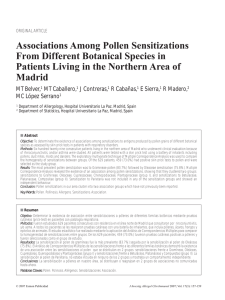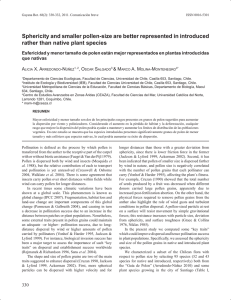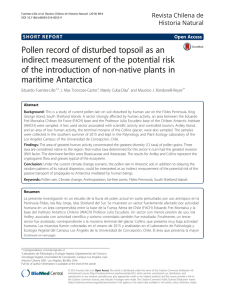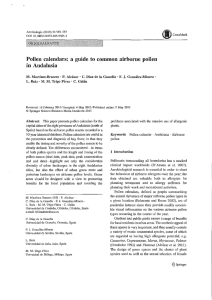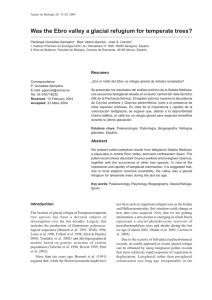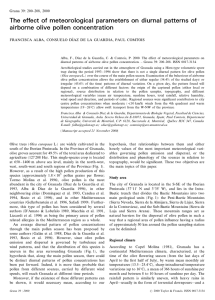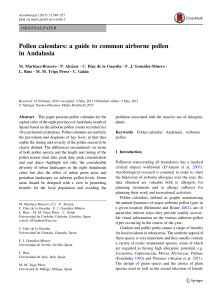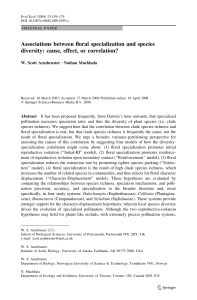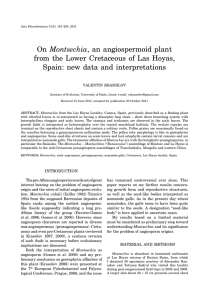The relationships between Poaceae pollination levels and cereal
Anuncio
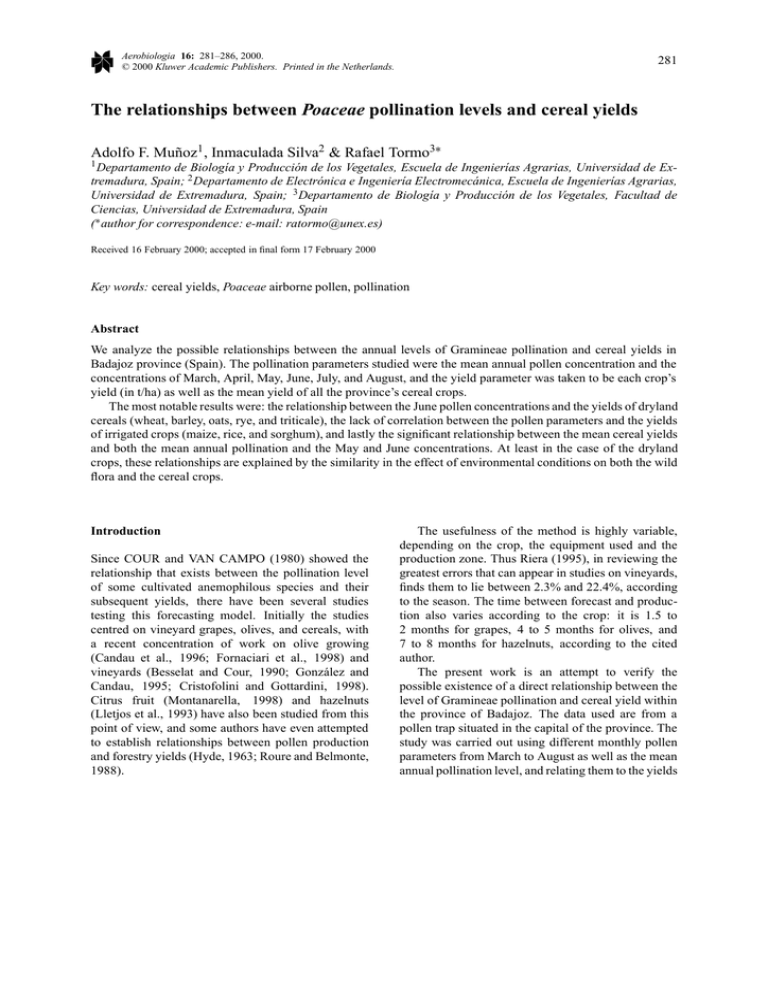
Aerobiologia 16: 281–286, 2000. © 2000 Kluwer Academic Publishers. Printed in the Netherlands. 281 The relationships between Poaceae pollination levels and cereal yields Adolfo F. Muñoz1 , Inmaculada Silva2 & Rafael Tormo3∗ 1 Departamento de Biologı́a y Producción de los Vegetales, Escuela de Ingenierı́as Agrarias, Universidad de Extremadura, Spain; 2 Departamento de Electrónica e Ingenierı́a Electromecánica, Escuela de Ingenierı́as Agrarias, Universidad de Extremadura, Spain; 3 Departamento de Biologı́a y Producción de los Vegetales, Facultad de Ciencias, Universidad de Extremadura, Spain (∗ author for correspondence: e-mail: ratormo@unex.es) Received 16 February 2000; accepted in final form 17 February 2000 Key words: cereal yields, Poaceae airborne pollen, pollination Abstract We analyze the possible relationships between the annual levels of Gramineae pollination and cereal yields in Badajoz province (Spain). The pollination parameters studied were the mean annual pollen concentration and the concentrations of March, April, May, June, July, and August, and the yield parameter was taken to be each crop’s yield (in t/ha) as well as the mean yield of all the province’s cereal crops. The most notable results were: the relationship between the June pollen concentrations and the yields of dryland cereals (wheat, barley, oats, rye, and triticale), the lack of correlation between the pollen parameters and the yields of irrigated crops (maize, rice, and sorghum), and lastly the significant relationship between the mean cereal yields and both the mean annual pollination and the May and June concentrations. At least in the case of the dryland crops, these relationships are explained by the similarity in the effect of environmental conditions on both the wild flora and the cereal crops. Introduction Since COUR and VAN CAMPO (1980) showed the relationship that exists between the pollination level of some cultivated anemophilous species and their subsequent yields, there have been several studies testing this forecasting model. Initially the studies centred on vineyard grapes, olives, and cereals, with a recent concentration of work on olive growing (Candau et al., 1996; Fornaciari et al., 1998) and vineyards (Besselat and Cour, 1990; González and Candau, 1995; Cristofolini and Gottardini, 1998). Citrus fruit (Montanarella, 1998) and hazelnuts (Lletjos et al., 1993) have also been studied from this point of view, and some authors have even attempted to establish relationships between pollen production and forestry yields (Hyde, 1963; Roure and Belmonte, 1988). The usefulness of the method is highly variable, depending on the crop, the equipment used and the production zone. Thus Riera (1995), in reviewing the greatest errors that can appear in studies on vineyards, finds them to lie between 2.3% and 22.4%, according to the season. The time between forecast and production also varies according to the crop: it is 1.5 to 2 months for grapes, 4 to 5 months for olives, and 7 to 8 months for hazelnuts, according to the cited author. The present work is an attempt to verify the possible existence of a direct relationship between the level of Gramineae pollination and cereal yield within the province of Badajoz. The data used are from a pollen trap situated in the capital of the province. The study was carried out using different monthly pollen parameters from March to August as well as the mean annual pollination level, and relating them to the yields 282 (t/ha) of the eight main cereal crops in the years from 1993 to 1998. degrees of significance in the correlations: p < 0.01 (***), 0.01 < p <0.05 (**), and 0.05 < p < 0.1 (*). Materials and methods Results The work was based on establishing regressions between different parameters relative to airborne concentrations of Gramineae pollen recorded from 1993 to 1998, and the yields of the different cereals grown in those years in the province of Badajoz in SW Spain. Pollen data were obtained using a Burkard trap situated in the city of Badajoz, in the Agronomic Engineering School of the University of Extremadura. It was placed at a height of 6 m above the ground, with no building obstructing the free flow of air in its surroundings. The daily samples were examined under optical microscopy, using four longitudinal sweeps at 400× magnification. The data obtained in the analysis were converted into daily concentrations of grains per cubic metre of air, which were then used to determine the following parameters: mean annual pollen concentration calculated by summing the year’s daily concentrations and dividing by the number of days on which Gramineae pollen appeared, and the total monthly concentration for each month from March to August, calculated as the sum of the daily Gramineae pollen concentrations during each month. The data relating to pollen production are shown in Figure 1. Annual cereal production data were obtained from two sources: the Consejería de Agricultura y Comercio of the Junta de Extremadura for 1993 to 1997, and the preliminary data published by the Ministerio de Agricultura, Pesca y Alimentación for 1998. These sources provide data on the production in t and the area under cultivation in ha for Badajoz province. From these, we obtained the annual yield in t/ha for the different cereals studied: five corresponding to mainly dryland crops (wheat, barley, oats, rye, and triticale) and three to irrigation crops (maize, rice, and sorghum). The data are given in Table 1. Since the variations in production may be largely due to variations in the area under cultivation in each year, we used the relative annual yield for each crop, together with the mean yield obtained by averaging the yields of the different crops in each year. Statistical analysis was performed by calculating the Pearson correlation coefficient r and the probability of its value being zero, then determining three Firstly, with respect to the mainly dryland cereals – wheat, barley, oats, rye, and triticale – Table 2 shows the values of the correlations between monthly pollen concentration and the cereal yields (not the area under cultivation) including the average yield. One observes a very low number of significant correlations. For instance, the mean annual Gramineae pollen concentration was only significantly correlated with the yield of rye, the only crop that showed significant correlations with the May pollen concentrations. The March, April, July, and August pollen concentrations were not significantly correlated with the yields of any of the crops studied. The June pollen concentrations, however, were significantly correlated with the yields of wheat, barley, rye, and triticale, and in the case of oats this parameter was that with the lowest p level although without reaching significance. Figure 2 shows the regressions carried out using the June pollen concentration parameter versus the yields of the cited cereals. The linear regression functions obtained were the following: y = 0.00035x − 0.0215 for wheat, y = 0.00032x − 0.1716 for barley, y = 0.00017x − 0.0643 for oats, 0y = 0.00018x + 0.0922 for rye, and y = 0.00030x − 0.1324 for triticale. Table 2 also gives the values of the correlations found with the three irrigation cereal crops. Only in the case of sorghum did there appear any significant correlation with the April pollen concentration parameter. The results of the regressions with the mean cereal yields of the province, Table 2, show that this parameter is correlated with the mean annual pollen concentrations and with the May and June concentrations. These correlations are shown in Figure 3, the error being less than 6%. Discussion and conclusions The usefulness of the parameters relating to airborne pollen concentrations in forecasting crop yields might be seen in different ways of representing those yields. In the case of cereal production in the province of Badajoz, however, it seems to be best to use the yields 283 Figure 1. Total concentrations from March to August, and mean annual Gramineae pollen concentration (grains/m3 ). Table 1. Production data (t), area under cultivation (ha), and yields (t/ha) for the crops studied in the province of Badajoz. Wheat Barley Oats Maize Sorghum Rice Rye Triticale 1993 Production Area Yield 11430 94515 0.12 3060 83300 0.04 1620 23700 0.07 3420 380 9.00 481 233 2.06 – – 0.05 – – 100 2189 1994 Production Area Yield 140925 75400 1.87 179552 92000 1.95 51720 40000 1.29 52500 7500 7.00 28500 9500 3.00 39000 6500 6.00 600 700 0.86 6400 4000 1.60 1995 Production Area Yield 28374 98920 0.29 25900 89920 0.29 4360 41200 0.11 10150 1450 7.00 250 100 2.50 500 100 5.00 200 750 0.27 500 4500 0.11 1996 Production Area Yield 216901 96790 2.24 109552 76480 1.43 28896 42000 0.69 292080 30000 9.74 851 120 7.09 119859 17052 7.03 5200 4000 1.30 11000 6080 1.81 1997 Production Area Yield 186377 117350 1.59 58807 70470 0.83 17962 41000 0.44 412764 42400 9.74 126000 18000 7.00 10350 16511 0.63 500 900 0.56 7200 6000 1.20 1998 Production Area Yield 186300 97270 1.92 69900 37750 1.85 33500 36000 0.93 448500 39000 11.50 600 800 0.75 121800 17400 7.00 800 700 1.14 6200 4100 1.51 284 Table 2. Correlation matrix between monthly Gramineae pollen concentration and the yields of the different crops including the average yields. The values are the Pearson coefficient correlation (r) and the probability of this being zero (p). Mean annual pollen March April May June July August Mean annual pollen March April May June July August Wheat r p Barley r 0.717 0.1091 0.600 0.2079 0.475 0.3410 0.140 0.466 0.667 0.789 0.272 0.791 0.8227 0.4291 0.1477 0.0622 0.6024 0.1071 −0.029 −0.013 0.533 0.805 0.083 0.433 0.9631 0.9835 0.2763 0.0536 0.8765 0.3909 −0.094 −0.052 0.412 0.713 0.053 0.321 0.8803 0.9344 0.4172 0.1118 0.9204 0.5355 Maize r p Sorghum r p Rice r p 0.587 0.2208 0.232 0.6577 0.630 0.2551 0.794 0.0594 0.638 0.047 0.341 0.681 0.689 0.726 0.2463 0.94 03 0.5088 0.1361 0.1300 0.1024 0.083 0.911 0.343 −0.035 0.233 0.590 0.8949 0.0312 0.5061 0.9477 0.6573 0.2179 −0.641 −0.076 0.680 0.566 −0.016 −0.377 0.2435 0.9028 0.2066 0.3204 0.9798 0.5311 −0.027 0.560 0.795 0.769 0.195 0.648 0.9661 0.3264 0.0589 0.0740 0.7118 0.1638 p Oats r p Rye r p Triticale r p 0.975 0.0046 0.719 0.1070 −0.090 0.375 0.871 0.951 0.765 0.465 0.8861 0.5336 0.0547 0.0129 0.1318 0.4300 0.084 0.450 0.670 0.798 0.276 0.684 0.8935 0.4476 0.1452 0.0573 0.5960 0.1337 Average yield r p Figure 2. Total Gramineae pollen concentrations measured in June (grains/m3 ) versus dryland cereal yields (t/ha). In each case, the calculated regression line is plotted. 285 Figure 3. Mean cereal yield (t/ha) versus total Gramineae pollen concentrations measured in May and June (A), and versus mean annual concentrations (B) in grains/m3 . expressed as t/ha, since part of the variation in production may be due to the major fluctuations in area under cultivation for each of the crops from one year to the next. Thus for instance, the barley production for 1994 was 179 552 t, more than twice that of 1998 with 69 900 t. On the basis of area under cultivation, however, 92 000 ha and 37 750 ha, respectively the two years have similar yields in t/ha. It is first of all notable that, as a result of testing the forecasting value of the Gramineae airborne pollen concentration using different parameters in the estimate of cereal yields in the province of Badajoz, the regressions that were calculated presented a low level of significance. In the case of the dryland cereals, the best estimator was the June pollen concentration, which was positively correlated with crop yields. The corresponding regression lines may be divided into two groups according to their slope: that of wheat, barley, and triticale which present slopes with values of b between 0.00030 and 0.00035, and that of oats and rye, with values of b of 0.00016 and 0.00018. 286 To understand this relationship, one must firstly take into account that these crops, with the exception of rye, are self-fertilizing species whose pollination takes place mostly within the closed flower, with hardly any release of pollen into the air (VALDEYRON 1984). The relationship between the Gramineae pollination levels and cereal yields can therefore only be understood at the level of the physiological relationship between the status of the wild Gramineae and that of the cited crop species, with the expectation that factors favouring the pollination of the former will favour the fruit-set of the latter. Because much of the dryland cereal harvesting is done in June, there may be an effect of the resuspension in the air of part of the pollen as a result of the mechanized harvesters. Another effect might be that when the year’s weather conditions have favoured the development and flowering of Gramineae that come into flower in this month, there is a concomitant good development and subsequent fruit-set of the crop cereals. With respect to the irrigated crops – rice, maize, and sorghum – their yields show no uniform correlation with the pollen parameters studied. The explanation of this could be that their growing conditions involve an alteration of the environment which has separated the reproductive behaviour of these plants from those that grow in wild conditions and which would be to a greater degree at the mercy of soil and weightier conditions. In general terms, however, the mean yields of the cereals grown in Badajoz do show a significant correlation with the mean annual Gramineae pollen content and with the concentrations of this pollen measured in May and June. Overall, this shows that the physiological responses of the Gramineae are generalized: conditions which affect the development of wild plants, the sources of airborne pollen, likewise affect the development of the crop cereals. Amongst the environmental parameters that have been studied and that affect Gramineae pollination, temperatures and rainfall are considered as of major importance (NORRIS-HILL, 1997). In the case of the mean yields of the cereals, the forecasting character of the pollen parameters might be of great value, since even in May they allow the goodness of the yields to be estimated. When each cereal is considered separately, these parameters lose their predictive value, since the present results have shown that their estimates are of a low level of significance, only valid for some late crops, since by June one is able to forecast crop production on the basis of real harvesting data. References Besselat B. and Cour P.: 1990, La prèvision de la production viticole á l’aide de la technique “Capture du pollen”. Inf. Tech. CEMAGREF 78(3), 1–4. Candau P., González F.J., Morales J. and Tomás C.: 1996, Predicciones de cosecha en el olivar basadas en estudios aeropalinológicos: Resultados de seis años de muestreo en la Campiña de Córdoba (SO de España). Actas del 1◦ Simposio Europeo de Aerobiología 149. Santiago de Compostela. Cour P. and van Campo M.: 1980, Prèvisions de récoltes á partir du contenu pollinique de l’atmosphère. C. R. Acad. Sc. Paris 290, 1043–1046. Cristofolini F. and Gottardini E.: 1998, Concentration of airborne pollen of Vitis vinifera L. and yield forecast: A case study at S. Michele all’Adige, Trento. Abstracts 6th International Congress on Aerobiology 291. Perugia. Fornaciari M., Pieroni L., Rossi A.C. and Romano B.: 1998, Yield forecasting model for the olive. Abstracts 6th International Congress on Aerobiology 281. Perugia. González F.J. and Candau P.: 1995, La aeropalinología como modelo de previsión de cultivos. I. Los viñedos del Condado de Huelva. Polen 7, 59–63. Hyde H.A.: 1963, Pollen-fall as a means of seed prediction in certain trees. Grana 4, 217–230. Lletjos L., Bartroli R., Esteban A. and Riera S.: 1993, Forecasting hazelnut (Corylus avellana L.) crop production based on monitoring airborne pollen concentration. IV International Symposium on Fruit, Nut, and Vegetable Production Engineering. Valencia-Zaragoza. Montanarella L.: 1998, The application of aeropalynological methods to the early forecast of european wine, olive oil and Citrus fruit production: From a local to a national forecast. Abstracts 6th International Congress on Aerobiology 283. Perugia. Norris-Hill J.: 1997, The influence of ambient temperature on the abundance of Poaceae pollen. Aerobiologia 13, 91–97. Riera S.: 1995, Estimación de cosechas en cultiuvos leñosos a partir del contenido polínico de la atmósfera. Fruticultura Profesional 68, 17–29. Roure J.M. and Belmonte J.: 1988, Primeros resultados para el estudio de las relaciones entre la producción polínica y la producción de biomasa de las comunidades forestales. VI Simposio de Palinología A.P.L.E. Salamanca, pp. 205–209. Valdeyron G.: 1984, Production de semenses pour quelques plantes de grande culture: céréales, graminées fourragères, betterave à sucre. In: P. Pesson and J. Louveaux (eds), Pollinisation et productions végétales. Paris, pp. 143–162.

